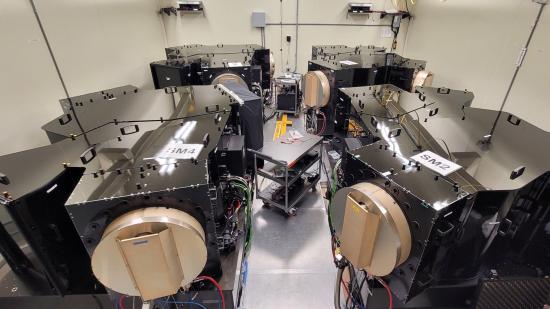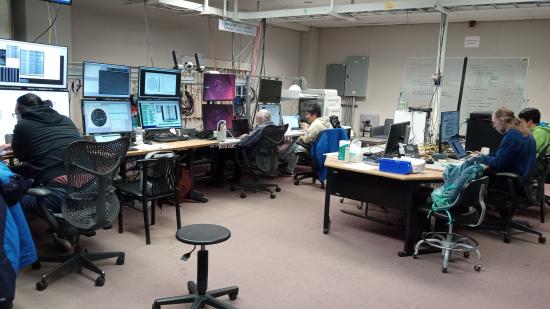April 26, 2024
Kavli Institute for the Physics and Mathematics of the Universe (Kavli IPMU, WPI)

The Prime Focus Spectrograph (PFS), mounted on the Subaru Telescope, is now counting down to launch.
PFS is a next-generation core observation instrument that will help researchers to uncover the nature of dark matter and dark energy by studying the spectra of light from distant objects in the Universe.
In parallel to delivering and assembling hardware components, the international team, led by Kavli Institute for the Physics and Mathematics of the Universe (Kavli IPMU, WPI), The University of Tokyo, and including the National Astronomical Observatory of Japan (NAOJ), has been continually conducting engineering tests and observations since September 2021. Mounted at the prime focus of the Subaru Telescope in Hawai`i, PFS is equipped with about 2400 fibers. With all four fiber cables and all four spectrograph modules now available, it is possible to deliver all ~2400 spectra simultaneously in every exposure. The commissioning process is indeed in the final phase.
The PFS team is currently analyzing the data taken during the last engineering observations during March 8-17, 2024, to better understand the various instrument characteristics, such as fiber positioning accuracy and instrument throughput. This will allow the team to improve the data reduction software and validate the observation procedure being developed for open-use science operation.

Two more engineering observation runs are scheduled in May and June 2024 as part of continuing preparations aiming to begin open-use science operations with PFS from the S25A semester starting on February 1, 2025.
Who is involved with developing the Prime Focus Spectrograph?
- Kavli Institute for the Physics and Mathematics of the Universe (Kavli IPMU, WPI), the University of Tokyo
- Subaru Telescope, and the National Astronomical Observatory of Japan
- Academia Sinica, Institute of Astronomy and Astrophysics (ASIAA)
- California Institute of Technology (Caltech)
- NASA Jet Propulsion Laboratory (JPL)
- Laboratoire d’Astrophysique de Marseille (LAM)
- Princeton University
- Johns Hopkins University
- IAG/Universidade de Sao Paulo
- Laboratorio Nacional de Astrofisica (LNA)
- Max-Planck-Institut für Astrophysik, Garching
- Max-Planck-Institut für extraterrestrische Physik
- Shanghai Jiao Tong University
- National Astronomical Observatories of China
- Tsinghua University
- The University of Science and Technology of China
- Xiamen University
- Peking University
- Columbia University
- Tufts University
- University of Connecticut
- University of Illinois at Urbana-Champaign
- University of Pittsburgh
- University of Massachusetts Amherst
- Pennsylvania State University
- North Western University
Related articles
Prime Focus Spectrograph passes significant testing milestone to capture light from many stars at once (November 11, 2022)
Related links
Engineering observation was carried out (April 12, 2024 PFS Blog)
Prime Focus Spectrograph Passes Significant Testing Milestone to Capture Light from Many Stars at Once (Subaru Telescope November 10, 2022 Topics)
Prime Focus Spectrograph (PFS) (Subaru Telescope 2.0 Key Instruments)
PFS Project Website
